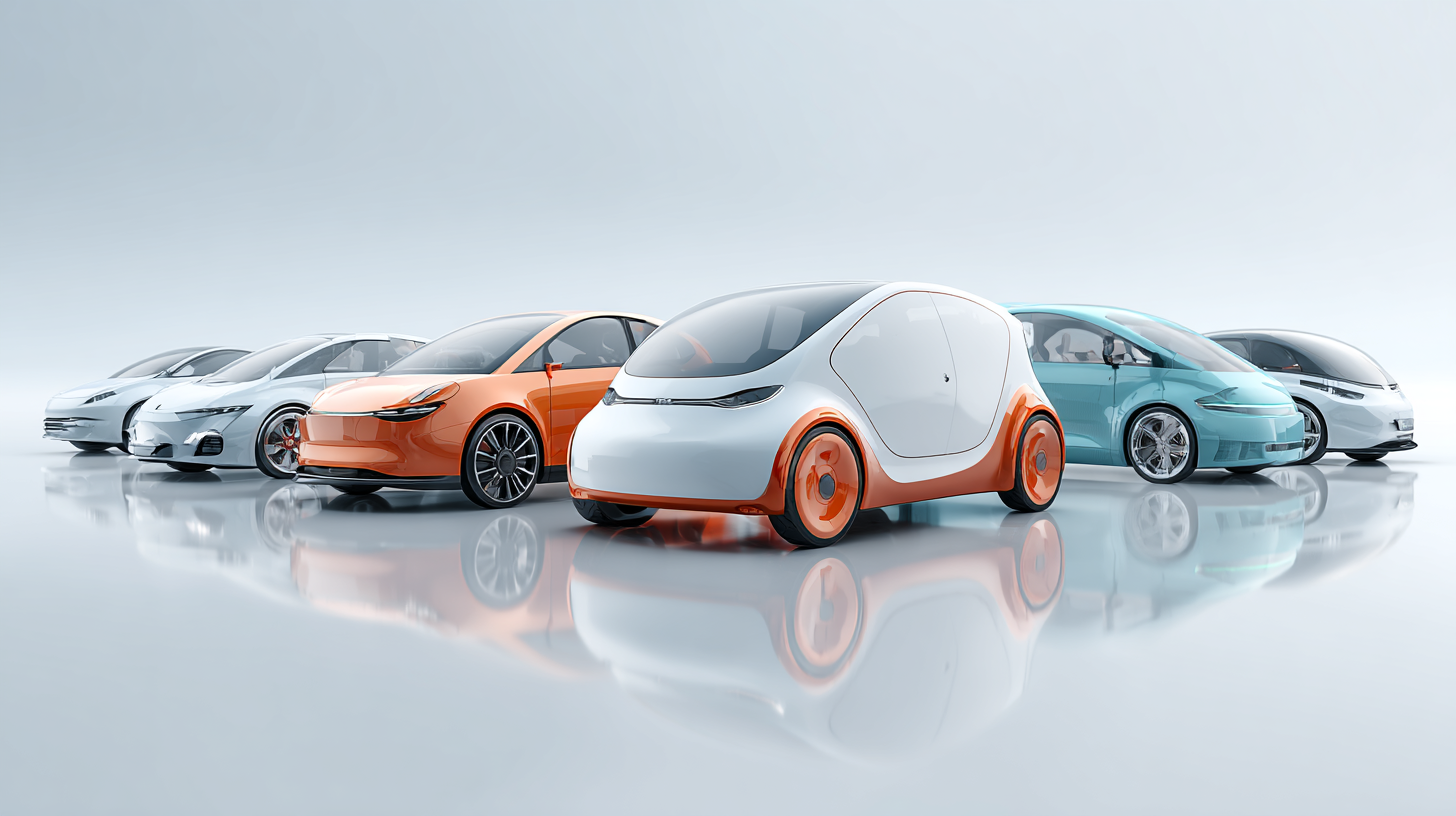As the world grapples with the urgent need for sustainable solutions to combat climate change, electric vehicles (EV Cars) have emerged as a pivotal player in reshaping the transportation landscape. According to the International Energy Agency (IEA), global sales of EVs surpassed 6.5 million units in 2021, marking a staggering 108% increase from 2020, and are projected to reach 18 million by 2030. This transition is driven by advancements in battery technology, decreasing costs, and supportive government policies aimed at reducing carbon emissions.

Furthermore, a report by BloombergNEF forecasts that by 2040, EVs could make up 58% of new car sales worldwide. As cities evolve and infrastructure adapts to accommodate this shift, understanding the future of sustainable transportation through the lens of EV Cars is crucial for stakeholders aiming to stay ahead in an increasingly eco-conscious market.
The electric vehicle (EV) market is witnessing unprecedented growth, driven by increasing environmental concerns and advancements in technology. According to the International Energy Agency (IEA), global sales of electric cars reached 6.6 million units in 2021, representing a staggering 9% of total car sales. This marks a significant increase from just 4.2 million in 2020. The trend is expected to continue, with projections suggesting that the number of electric vehicles on the road could reach 145 million by 2030 if supportive policies and infrastructure are implemented.

In terms of market share, a report from BloombergNEF forecasts that electric cars will represent 58% of new car sales by 2040, with some regions seeing even higher adoption rates. The decline in battery costs, which are projected to drop by 50% from their 2021 levels by 2030, is a crucial factor in making EVs more affordable and accessible. Additionally, with over 1,300 models projected to be available by 2025, consumers will have more options than ever, further promoting the transition towards sustainable transportation. As governments worldwide implement stricter emissions regulations and offer incentives for EV purchases, the growth trajectory of the electric vehicle market seems increasingly promising.
The global shift towards sustainable transportation is significantly influenced by several key factors driving the adoption of electric vehicles (EVs). One major contributor is the growing awareness of environmental issues, particularly the impact of carbon emissions from traditional gasoline and diesel vehicles. Governments around the world are responding by implementing stricter emissions regulations and offering incentives for EV purchases, making them increasingly attractive to consumers. This policy support, coupled with advancements in battery technology, has led to improvements in driving range and charging speeds, addressing common concerns that potential buyers may have about electric vehicles.
Another critical factor is the rapid development of charging infrastructure. As more public and private charging stations emerge, the convenience and accessibility of EVs are enhanced, facilitating their widespread acceptance. Additionally, the decreasing cost of electric vehicle technology, particularly batteries, has made EVs more affordable for the average consumer. This, combined with the rising costs of fossil fuels and the stabilization of electric prices, positions EVs not just as an eco-friendly alternative, but also as a financially viable choice for many individuals and businesses. These elements together herald a promising future for electric mobility on a global scale.
The environmental impact of transportation is a pressing concern in the face of climate change, and the shift from traditional internal combustion engine (ICE) vehicles to electric vehicles (EVs) presents a significant opportunity for reduction in greenhouse gas emissions. ICE vehicles rely on fossil fuels, releasing carbon dioxide and other harmful pollutants into the atmosphere, which contribute to air quality degradation and global warming. In contrast, EVs utilize electricity, which can be sourced from renewable energy, drastically lowering the overall carbon footprint associated with their operation.

Moreover, the production and disposal of EVs also have an environmental dimension that must be considered. While manufacturing EVs typically results in higher initial carbon emissions due to battery production, the long-term benefits manifest during the operational phase. Studies indicate that over their lifetime, EVs can lead to significantly lower total emissions compared to conventional vehicles, especially as the energy grid becomes greener. Additionally, advancements in battery recycling technologies are improving the sustainability of EVs, addressing concerns related to resource extraction and waste. This holistic view underscores the crucial role of EVs in achieving a more sustainable transportation future.
The rapid advancement of technology is significantly enhancing the performance and charging infrastructure of electric vehicles (EVs). Innovations such as solid-state batteries are revolutionizing energy storage and efficiency, offering greater energy density and faster charging times compared to traditional lithium-ion batteries. This leap in technology means that EVs can travel longer distances on a single charge, addressing range anxiety, a common concern among potential users. Additionally, the development of ultra-fast charging stations allows drivers to replenish battery power in a fraction of the time previously required, making EVs more convenient for everyday use.
Moreover, smart charging solutions are emerging, leveraging artificial intelligence and real-time data to optimize the energy consumption of EVs. These systems can schedule charging during off-peak hours to reduce costs and strain on the grid while also integrating renewable energy sources. As cities invest in robust charging networks that feature wireless and vehicle-to-grid technologies, the future of sustainable transportation becomes more accessible. This infrastructure expansion, combined with continual technological innovations, positions EVs as a viable alternative to conventional vehicles, paving the way for a greener transportation landscape.
The chart illustrates the performance metrics of electric vehicles (EVs) in 2020 and 2023, showcasing improvements in range, charge time, battery capacity, and cost. These advancements reflect the ongoing technological innovations enhancing EV performance and their charging infrastructure.
As electric vehicles (EVs) gain popularity, governments around the world are implementing policies and incentives to promote sustainable transportation solutions. These strategies often include tax breaks for EV buyers, subsidies for charging infrastructure, and stricter emissions regulations for traditional vehicles. By creating a favorable environment for consumers and manufacturers alike, governments aim to accelerate the transition to cleaner transportation options, which is crucial for combating climate change and reducing air pollution.
Tips: If you’re considering purchasing an EV, research your local government incentives first. Many regions offer hefty rebates that can significantly lower the initial cost of buying an electric vehicle. Additionally, look into grants available for home charging station installation to make your transition even more cost-effective.
Moreover, some governments are investing in enhancing public transportation systems to not only reduce reliance on personal vehicles but also incorporate electric buses and trains. This investment not only addresses traffic congestion but also supports overall sustainability goals.
Tips: Stay informed about upcoming initiatives in your area, as new programs may expand the availability of grants or benefits for adopting electric vehicles or using public transportation. Participating in community forums can also be a great way to advocate for greener local policies.
| Country | Government Incentives | Percentage of EV Sales | Charging Infrastructure (stations per million people) | Projected EV Market Growth (% CAGR 2023-2030) |
|---|---|---|---|---|
| Norway | Tax exemptions, free tolls | 55% | 116 | 25% |
| Germany | Purchase bonuses, tax reductions | 30% | 40 | 20% |
| China | Subsidies for manufacturers, tax incentives | 11% | 80 | 15% |
| United States | Federal tax credit, state rebates | 5% | 20 | 18% |
| France | Conversion bonuses, reduced registration fees | 17% | 34 | 22% |






